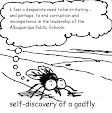 |
| Journal Editor Kent Walz |
Standards Based Assessment, wikilink, is supposed to measure student learning, and by extension, school performance. The tests are a poor measure of both. Imagine a test designed for "all" students that really measures the individual performance of each. They are an attempt to create global statistics in order to create global solutions requiring huge industries including the testing industry. A Google search for "problems with Standards Based Assessment" produces nearly 20 million hits; not all inconsequential.
If I may point to one; even students who have "passed" SBA tests and who have "graduated" from high school, cannot be considered, based on the test results, to be prepared for work or college. Colleges and university classes are filled with students who passed SBA tests and have diplomas and still had to take remedial classes before they could undertake college classwork.
The Journal editors are much impressed with a few percentage points improvement in test scores. The gains are small enough, I wouldn't be surprised to find a statistical source for the gain. APS has raised their graduation rates twice in the past; once by adding another year to high school and once by dropping from the cohort, students who had failed the 9th grade already. Graduation rates improved, education did not.
The editors seem to miss the point the improvement is from failing miserably to failing a little less miserably. It isn't OK that nearly half of students still leave APS functionally illiterate, even if it's 2 percent fewer than the year before.
Even if the few percent growth per year is sustainable, it isn't, it will take 15 years to reach a point where 9 out of 10 students leave high school the skill set they need to lead happy and productive lives.
The growth isn't sustainable because a 50% failure rate in any endeavor is an indication of a fundamental flaw in the model; not of a conglomeration of little problems that can be fixed at a rate of 2 or 3% a year.
Fixing a fundamental flaw in any system can be expected to raise performance by tens of percent or more. Two percent growth in not an indicator of a fundamental fix. Inconsequential fixes may raise scores a little one year or two, but there aren't enough of them to make to lower the overall failure rate to an "acceptable" level.
Incremental growth does not follow fundamental change. Incremental growth , like no growth at all, is an indicator of the lack of fundamental change.
 |
| APS' Spin Doctor, Monica Armenta |
- about three-quarters of Albuquerque public schools made gains
- APS’ test results exceeded scores for students around New Mexico.
- all 13 comprehensive APS high schools showed gains in at least one category, including 9 that improved in both reading and math.
- Twenty-four of 27 middle schools gained in one category, with 13 improving in both.
- Improvements also were seen in 58 elementary schools, including 22 in both categories.
- 99 of 133 schools tested gained in at least one category, 54 of them in both categories.
- The achievement gap between Anglo students and Hispanics narrowed, as well as the gaps with English language learners and economically disadvantaged students.
APS steadfastly refuses to recognize the standing of the Citizen's Advisory Council on Communications and their effort to establish a public forum where we can talk openly and honestly about the fundamental flaws in the APS' approach to education nearly 90,000 of this community's sons and daughters.
Chalk one up for the spinmeister and the aid and abet she gets from the Journal.
photos Mark Bralley

No comments:
Post a Comment